Pilot Channel Project
 Recently, I was contacted by a customer who was having some problems with standing water at his pond outfall.
Recently, I was contacted by a customer who was having some problems with standing water at his pond outfall.
He stated that the concrete pilot channel had some mud on it that needed to be removed because the area at the outfall was perpetually soggy. This was becoming an issue as the lawn maintenance crew could not access this area to mow.
Assessment
The pond is 7 years old and has been mowed quarterly since it was built. Since inception, no additional treatments, i.e., fertilizer, overseed, or grading, have been done. The customer stated that these developments were new, and the pond drained fine until recently. My site investigation revealed some interesting observations. Upon first looking at the outfall area, I noticed a small chain link fence gate on the outfall pipe intended to keep large debris from leaving the pond.
This is not necessarily a problem in and of itself but a cause for concern. If not properly maintained, trash screens build up thatch and can clog the outfall. Upon further investigation, I did see some thatch at the outfall, but I also noticed an onsite wastewater treatment plant (WWTP) that discharges to the pond. Again, not a problem in itself, but just like any septic system, water is the end product and needs to go somewhere. In this case, a pipe discharges to the pond slope.
These commercial plants are almost always draining a small amount of water instead of a start/stop cycle that you might see in an aerobic septic system. That means that the area at the WWTP discharge will always remain wet if not properly designed. An examination of the overall pond revealed several areas on the pond slopes that were washed out or “rilled.” In addition I found evidence of cut down Typha Latifolia aka. “Cattails”. Now if you only know one thing about cattails it’s that they grow in shallow water.
So when I see this, I immediately know that these areas were wet for quite some time, revealing a possible grading or drainage issue.
At this point, I only know two things for sure:
1. We need to clean off the pilot channel to get as much flow as possible.
2. We need to get the water from the WWTP to the pilot channel to keep the soil dry between rain events.
The Solution
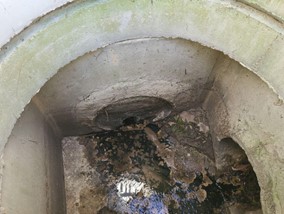 I suggested cleaning off the existing pilot channel and adding a new concrete pilot channel from the WWTP to the primary pilot channel.
I suggested cleaning off the existing pilot channel and adding a new concrete pilot channel from the WWTP to the primary pilot channel.
I also questioned the need for the trash screen. After discussing with the client, we decided to remove it, as it was never a permitted or specified feature in the first place.
However, I did voice my concerns about removing this screen because this particular pond (like most) has a 6” restrictor pipe that could potentially clog with debris and mowed vegetation.
Additional Issues Uncovered
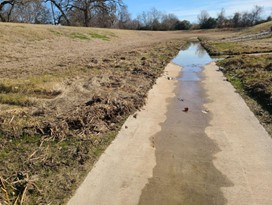 After cleaning off the pilot channel, several new issues were revealed:
After cleaning off the pilot channel, several new issues were revealed:
1. The pilot channel has a high spot that holds back several inches of water about 100 ft from the outfall.
This, combined with the constant flow from the WWTP, explains the cattails and mushy ground.
2. The grassy areas adjacent to the pilot channel are 6 inches higher than the pilot channel. This might not seem problematic but is not a typical design.
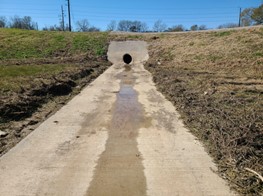 The question is, was this always the case, or did something happen to cause this sediment buildup at the outfall area?
The question is, was this always the case, or did something happen to cause this sediment buildup at the outfall area?
The site received about an inch of rain a week after cleaning the pilot channel.
The customer called to tell me that the pilot channels were full of sediment again.
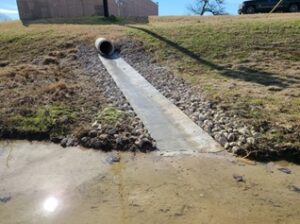 We cleaned off the pilot channels…again, added the new pilot channel to serve the WWTP, removed the trash screen from the outfall, and then… It rained AGAIN!
We cleaned off the pilot channels…again, added the new pilot channel to serve the WWTP, removed the trash screen from the outfall, and then… It rained AGAIN!
Why Maintenance Matters
The customer called to tell me that the pond was now holding about a foot of water and that this had never happened before, suggesting that we had done something to cause this.
It reminds me of what happens when you get your oil changed, and the water pump goes out… It must be the mechanic’s fault. It couldn’t be that the car’s owner didn’t do any maintenance and his car broke!
Anyway, I went to investigate, and sure enough, the cattail cuttings were clogging the restrictor pipe. So we unclogged it, and I reminded the owner of our previous conversation about the restrictor and trash screen.
These may sound like unrelated problems, but let me break it down and I’m sure you’ll see that these issues are all interrelated. This is, in fact, a global problem and not a series of localized ones.
The Difference When Maintaining Detention Ponds
First, let’s start with the overall pond. Remember that everything in the pond (trash, clippings, eroded soil) will migrate toward the outfall. I tell you this to explain the 6 inches of additional sediment adjacent to the pilot channel at the outfall and the high spot in the pilot channel. This all starts with maintenance.
Remember that the owner told me they mow the pond quarterly, and that’s the extent of pond maintenance, and the landscapers perform that work. Unfortunately, the blade height setting landscapers use, while fine for flat areas, is detrimental to the health of slope vegetation.
On ponds, we set the blades as high as they go (6 inches) to prevent scalping and encourage root growth. Additionally, these infrequent mowings allow vegetation to grow as high as 3-4 ft in 3 months.
Then the vegetation is mowed down into a large thatch that migrates to the outfall structure, clogging the trash screen.
To make matters worse, we’ve lost all of the nutrients that would have been reintroduced back into the pond had we mowed monthly. More frequent mowings mean shorter, less bulky vegetation that can easily be mulched back into the existing grass, reintroducing Nitrogen back into the soil.
As time goes on, the grasses become stressed and start to weaken or die in some areas, exposing the soil. This exposed soil is now subject to erosion, which happens fairly quickly, and explains why so often I hear that the pond looked good last year, last month, last week, etc.
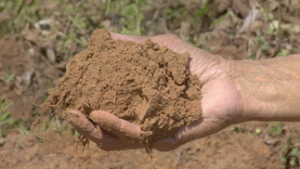 The eroded soil now migrates onto the pilot channel, eventually moving toward the outfall structure. You remember, the one clogged with thatch and debris from infrequent mowings.
The eroded soil now migrates onto the pilot channel, eventually moving toward the outfall structure. You remember, the one clogged with thatch and debris from infrequent mowings.
The soil and thatch form a dam, holding 6-12 inches of water and allowing sediment to drop out of suspension.
This isn’t good sediment either. It’s mostly fine silt with no structural stability and little to no organics, so this is just junk dirt that needs to be removed.
We now have excellent conditions for those undesirable cattails that love wetland habitats…which this situation has created. From here, if not corrected, things go downhill fast.
Stormwater Maintenance & Landscaping Should Be Separate
The good news is that these issues and associated costs can be avoided with regular maintenance by qualified personnel. We mow around 100 detention ponds monthly but do no flat mowing or landscaping.
So why would you have two companies mowing?
Our customers understand that while it would seem to make sense for a landscape contractor to mow the detention pond as well as the finish areas, this is a different scope requiring different equipment and expertise. Expertise that most landscape contractors just don’t have.
In fact, we’ve been approached by several commercial landscape contractors looking to sub out their detention pond mowing contracts. In addition, we spend much of our time repairing ponds that were slowly destroyed by improper mowing and maintenance by landscapers.
The good news is that these problems typically develop slowly, meaning they can usually be corrected without breaking the bank.
And if you have experienced professionals that know what to look for, putting eyes on your pond monthly, these localized issues won’t have time to develop into global issues and associated costly repairs.
If you would like to learn more about how we can help you with your specific needs please feel free to contact us for a complimentary site assessment. Give us a call today at (832) 554-6654 or email us at info@swpgrp.com
